|
|
 |
Fiche d'espèce de Copépode |
|
|
Calanoida ( Ordre ) |
|
|
|
Clausocalanoidea ( Superfamille ) |
|
|
|
Euchaetidae ( Famille ) |
|
|
|
Paraeuchaeta ( Genre ) |
|
|
| |
Paraeuchaeta biloba Farran, 1929 (F,M) | |
| | | | | | | Syn.: | Pareuchaeta biloba Farran, 1929 (p.208, 242, figs.F,M); Hardy & Gunther, 1935 (1936) (p.161, Rem.); Yamanaka, 1976 (p.170);
Euchaeta biloba : Vervoort, 1957 (p.79, figs.F,M, Rem.); Grice & Hulsemann, 1967 (p.15); Rudyakov, 1972 (p.886, Table 1: sinking rate); Bradford, 1972 (p.40, figs.F,M); Arcos, 1976 (p.85, Rem.: p.93, Table II); Park, 1978 (p.217, figs.F,M); Séret, 1979 (p.97, 107, figs.F, juv.); De Decker, 1984 (p.316); Dearborn & al., 1986 (p.1, predation by benthic star); Zmijewska, 1987 (tab.2a); Ward & Wood, 1988 (p.45, tab.1); Ward, 1989 (tab.2); Øresland & Ward, 1993 (p.73, diet); Mauchline, 1998 (tab.64) | | | | Ref.: | | | Björnberg & al., 1981 (p.633, 635, figs.F,M); Bradford & al., 1983 (p.29, figs.F,M); Razouls, 1994 (p.89, figs.F,M, Rem.); Park, 1994 (p.321); 1995 (p.80, Redescr.F,M, figs.F,M); Mazzocchi & al., 1995 (p.182, figs.F,M, Rem.); Bradford-Grieve & al., 1999 (p.880, 926, figs.F,M) |  issued from : G.P. Farran in British Antarctic (\"Terra Nova\") Expedition, 1910. Natural History Reports. Zoology. Vol. VIII. Crustacea, 1929. [p.212, Fig.11]. Female: a, genital segment (right lateral view); b, idem (ventarl view); c, rostrum; d, furca; e, genital plates (ventral view); f, first foot; g, second and third joints of exopodite of second foot. Male: h, right fifth foot; i, left fifth foot; j, terminal joints of left fifth foot.
|
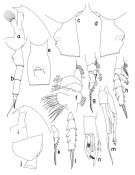 issued from : T. Park in Bull. Scripps Inst. Oceanogr. Univ. California, San Diego, 1995, 29. [p.187, Fig.77]. Female: a, forehead (left side); b, urosome (left); c, d, e, genital somite (left, right, ventral, respectively); f, Mx1 (first inner lobe separated), posterior; g, P1 (anterior); h, P2 (anterior). Nota: Large rostrum pointing at an angle of about 20° with respect to anterior dorsal margin of forehead. Mx1 with 1 anterior, 9 marginal, and 1 posterior seta on 1st inner lobe, 2nd inner lobe without a seta, basis with 3 setae. Male: i, forehead (left); j, last pedigerous and genital somites (left); k, exopod of P1 (anterior); l, exopod of P2 (anterior); m, P5 (anterior); n, distal exopodal segments of left 5th leg (medial).
|
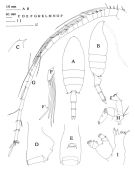 issued from : J.M. Bradford, L. Haakonssen & J.B. Jillett in Mem. N.Z. Oceanogr. Inst., 1983, 90. [p.14, Fig.3 (legend: p.15)]. Female: A, habitus (dorsal); B, idem (lateral right side); C, forehead (lateral); D, genital segment (lateral right side); E, idem (ventral); F, caudal ramus (ventral view); F', appendicular seta; G, A1; H, A2; I, Md. Nota: - P1 exopod: Bb ≤ BC; Cc ± BC. - P2 exopod: Aa = 1/2 AB; Bb = 1/3 BC; Cc = 1/3 CD; Dd = 11/5 CD. (see code of lengths outer spine in the Genus' figure of Paraeuchaeta, or in Paraeuchaeta sp. A). After Bradfiord & al. (1983) some south-west Pacific female specimen as figured here have longer outer edge spines on P2 exopod than on previously specimens.
|
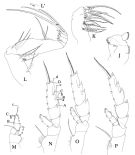 issued from : J.M. Bradford, L. Haakonssen & J.B. Jillett in Mem. N.Z. Oceanogr. Inst., 1983, 90. [p.15, Fig.4]. Female: J, Mx1; K, Mx2; L, Mxp; L', tip of endopod seta of Mxp; M, P1 (with code of length of outer spines); N, P2 (with code of length of outer spines); O, P3; P, P4. Nota: Some south-west Pacific female specimens have longer outer edge spines on P2 exopod than on previously described specimens.
|
 issued from : J.M. Bradford, L. Haakonssen & J.B. Jillett in Mem. N.Z. Oceanogr. Inst., 1983, 90. [p.16, Fig.4 (legend p.15)]. Male: A, habitus (dorsal); B, idem (lateral left side); C, forehead (lateral); D, A1; F, Md; G, Mx1; H, Mxp.
|
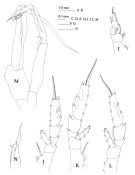 issued from : J.M. Bradford, L. Haakonssen & J.B. Jillett in Mem. N.Z. Oceanogr. Inst., 1983, 90. [p.17, Fig.4]. Male: I, P1; J, P2; K, P3; L, P4; M, P5; N, serrated lamella of left P5. Nota: Left P5 of south-west Pacific male specimens is generally similar to those figured by Vervoort (1957) and Park (1978), but the serrated lamella appears to differ in details. P1 exopod: Bb = 5/7 BC; Cc = 7/10 BC. P2 exopod: Aa = 3/10 AB; Bb = 1/4 BC; Cc = 1/4 CD. (see code of lengths outer spine in the Genus' figure of Paraeuchaeta, or in Paraeuchaeta sp. A). After Bradford & al. (1983) left P5 of south^west Pacific male specimens is generally similar to those figured by Vervoort (1957) and Park (1978), but the serrated lamella appears to differ in details. The hollow part of the serrated lamella is located at mid-length, one side is bordered with 1 large tooth and a row of smaller teeth which extends along the basal part of the lamella, the other side is bordered by 1 large and 1 to 4 smaller teeth.
|
 Issued from: M.G. Mazzocchi, G. Zagami, A. Ianora, L. Guglielmo & J. Hure in Atlas of Marine Zooplankton Straits of Magellan. Copepods. L. Guglielmo & A. Ianora (Eds.), 1995. [p.184, Fig.3.32.1]. Female: A, habitus (dorsal); B, urosome (dorsal). Nota: Proportional lengths of urosomites and furca 38:24:24:2:12 = 100. Male: C, habitus (dorsal); D, urosome (dorsal). Nota: Proportional lengths of urosomites and furca 22:29:24:17:2:6 = 100. Genital somite asymmetrical (more produced on left side in dorsal view).
|
 Issued from: M.G. Mazzocchi, G. Zagami, A. Ianora, L. Guglielmo & J. Hure in Atlas of Marine Zooplankton Straits of Magellan. Copepods. L. Guglielmo & A. Ianora (Eds.), 1995. [p.185, Fig.3.32.2]. Male: A, 1st and 2nd urosomal somites (dorsal); B, 1st urosomal somite (lateral right side); C, forehead (dorsal); D, idem (lateral right side); E, right P5; F, left P5; G, detail of last segment of left P5.
|
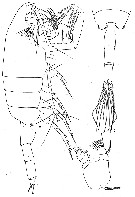 issued from : W. Vervoort in B.A.N.Z. Antarctic Reseach Expedition, Report Ser. B, Vol. III., 1957 [Fig.60]. As Euchaeta biloba. Female (from 47°43'S, 76°48'E): a, habitus (lateral); b, posterior part cephalothorax and urosome (dorsal); c, right Md (mandibular palp). Nota : Proportional lengths of cephalothorax and abdomen as 85 :51. Head in dorsal view rounded into the slightly protruding frontal organ ; frontal organ situated at the base of the rostrum, distinctly visible. Urosome 4-segmented ; proportional lengths of the somites with the caudal rami 37 :25 :26 :5 :7 = 100. Extreme caudal part of the ventral surface of the genital somite haired, dorsal part of the distal border set with small, leaf-like spinules. 2nd and 3rd abdominal somites with some small spinules at the dorsal part of the distal border. Anal somite small, more or less triangular. Caudal rami 1.5 times as long as wide, with nearly parallel margins, cut off obliquely at the extreme distal border, external margin densely haired ; the oblique distal border carries 4 long, densely plumose setae, in addition each ramus carries a small and curved external (dorsal) seta and a geniculated, greatly lengthened ventral (appendicular) nude seta. A1 23-segmented (8th-9th segments, 24th-25th segments completely fused), reaching (extended condition) the middle of the fused 4th-5th thoracic somites. Endopod of A2 2/3 the length of the exopod. Mx1 with a curiously shaped 2nd basal segment, which curves over the 1st inner lobe of the 1st basal segment and almost completely hides the 2nd inner lobe ; 1st inner lobe with 11 spiniform setae, these setae are either spinulose or set with a row of fine teeth (2 or 3 of these setae are placed on the anterior surface of the lobe) ; 1st outer lobe with 6 strong, plumose setae ; exopod small with 11 setae of very unequal length ; endopod 3-segmented with respectively2strong + 1 fine seta, 1 strong + 1 fine seta, 3 strong setae ; external margin of the 3rd endopodal segment set with a row of fine hairs. Mxp with greatly lengthened basal segments and a short endopod.
|
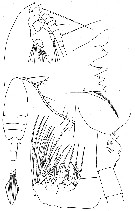 issued from : W. Vervoort in B.A.N.Z. Antarctic Reseach Expedition, Report Ser. B, Vol. III., 1957 [Fig.82]. As Euchaeta biloba. Female: a, forehead (lateral); b, Md (cutting edge); c, habitus (dorsal); d, posterior part cephalothorax and 1st and 2nd urosomal somites (lateral); e, right Mx2.
|
 issued from : W. Vervoort in B.A.N.Z. Antarctic Reseach Expedition, Report Ser. B, Vol. III., 1957 [Fig.62, 63]. As Euchaeta biloba. Female: Fig.62: a-b, left A1; c, left Mx1; d, left A2; e, left Mxp. Fig.63: a, right P1 (anterior); b-d, P2 to P4 (left legs).
|
 issued from : W. Vervoort in B.A.N.Z. Antarctic Reseach Expedition, Report Ser. B, Vol. III., 1957 [Fig.64]. As Euchaeta biloba. Male: a, habitus (lateral); b, P5 (lt = left leg; rt = right leg); c, distal portion of left P5; d, forehead (dorsal). Nota : Proportional lengths of cephalothorax and abdomen as 27 :11. Rostrum with a rather thick base, directed obliquely forwards, frontal organ prominent ; Postero-lateral border in lateral aspect produced into a small, rounded lappet, covering the beginning of the genital somite, ventral portion of that margin haired, dorsal portion with a small, slightly ventrally curved spinule. Urosome 5-segmented (5t somite telescoped into 4th ; proportional lengths with caudal rami 21 :28 :25 :16 :1 :9 = 100. Genital somite asymmetrical ; in lateral view it shows a distinctly produced ventral tubercle, slightly over-lapping the 2 nd abdominal somite ; in dorsal view it appears to be produced on the left side, where a genital orifice, in the shape of a small slit, is distinctly discernible ; 2nd-4th abdominal somites armed with teeth along the distal borders. Caudal rami slightly longer than wide (proportions 5 :4), almost parallel. A1 2-segmented (8th-9th, 24th-25th segments completely fused, 7th incompletely separated from 8th-10th, 12th-13th too incompletaly separated), point forwards in extended condition, they are slightly longer than the cephalothorax. The mouth parts much reduced. The legs differ from those of the female ; all setae of the legs (P1 to P4) are very plumose, much more sot han in the female (they must have greatly facilitated the swimming movements).
|
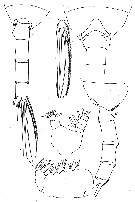 issued from : W. Vervoort in B.A.N.Z. Antarctic Reseach Expedition, Report Ser. B, Vol. III., 1957 [Fig.65]. As Euchaeta biloba. Male: a, posterior part cephalothorax and urosome (dorsal); b, right caudal ramus; c, posterior part cephalothorax and 1st and 2nd urosomal somites (dorsal); d, posterior part cephalothorax and urosome (lateral from right side); e, Md (mandibular palp); f, right Mx2.
|
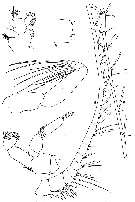 issued from : W. Vervoort in B.A.N.Z. Antarctic Reseach Expedition, Report Ser. B, Vol. III., 1957 [Fig.66]. As Euchaeta biloba. Male: a, right Mx1; b, Md (manducatory edge); c, right Mxp; d-e, left A1; f, left A2.
|
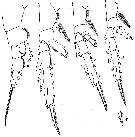 issued from : W. Vervoort in B.A.N.Z. Antarctic Reseach Expedition, Report Ser. B, Vol. III., 1957 [Fig.67]. As Euchaeta biloba. Male: a, right P1 (anterior); b-d, P2 to P4 (left legs); d', distal part of terminal spine of P4.
|
 issued from : J.M. Bradford in Mem. N. Z. Oceonogr. Inst., 1972, 54. [p.41, Fig.8, (9-13)]. As Euchaeta biloba. Female (from Kaikoura, New Zealand): 10, habitus (lateral). Male: 9, habitus (dorsal); 11, lamella of exopodal segment 2 of left P5; 12, distal part of left P5; 13, P5. Scale bars: 1 mm (9, 10, 13); 0.1 mm (11, 12). The most common Euchaeta species caught in Kaikoura region.
|
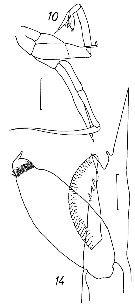 issued from : D.F. Arcos in Rev. Com. Perm. Pacifico Sur, 1976, 5. [Figs. 10, 14]. Male (from Magallanes region): 10, P5; 14, exopodal lamella of P5. Scale bars: 500 µ (10); 50 µ (14). Nota: environmental conditions: temperature 3.96 °C to 8.48 °C and salinity 27.47 to 33.33 p.1000.
|
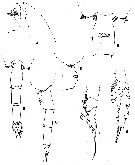 issued from : T. Park in Biology of the Antarctic Seas VII. Antarctic Res. Ser., 1978, 27 (4). [p.218, Fig.74]. As Euchaeta biloba. Female: A, forehead (lateral); B-C, posterior part of body (dorsal and left side, respectively); D-E, last metasomal and genital segments (right side and ventral, respectively); F, P1 (anterior); G, P2 (anterior).
Nota : Proportional lengths of prosome and urosome 63 : 37.
Frontal eminence of forehead prominent, bearing suprafrontal sensilla ; rostrum moderately developed, pointing obliquely forward at angle of about 70° with respect to body.
Posterolateral corner of metasome slightly produced posteriorly, covering only about 1/6 of genital segment, with its distal mùargin broadly rounded in either dorsal or lateral view. Dorsally, genital segment symmetrical, little over twice as long as wide, with its widest part at middle of segment. Anterior ¼ of genital segment forming narrow neck. Laterally, genital prominence with wide base occupying most of genital segment, gradually narrowing distally into bilobed top formed by outgrowths of anterior and posterior borders of genital field (fig.D). Genital flanges not definable. Ventrally, genital field asymmetrical and slightly rotated counterclockwise (fig.E)). Appendicular caudal setae arising from short cylindrical process, geniculated, slightly thinner but much longer than terminal setae.
A1 scarcely reaching distal end of metasome. Outer coxal lobe of Mx1 with 6 long setae.
In Mx2, none of 6 apical setae bearing long spines in addition to usual short spinules.
Mxp : long endopodal setae terminating in spinule.
In P1, first 2 exopodal segments fused, but fusion indicated only by short line on external margin 1st segment without external spine ; external spine of 2 nd segment reaching distal end of 3rd.
In P2, external spines of exopod small. Incision posterior to 2 nd external spine of 3rd exopodal segment moderately deep.
|
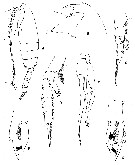 issued from : T. Park in Biology of the Antarctic Seas VII. Antarctic Res. Ser., 1978, 27 (4). [p.219, Fig.75]. As Euchaeta biloba. Male: A, habitus (lateral); B, forehead (lateral); C, P1 (anterior); D, P2 (anterior); E, P5 (anterior); F, distal end of exopod of left P5 (lateral); G, same (medial).
|
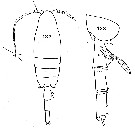 Issued from : C. Séret in Thesis 3ème Cycle, UPMC, Paris 6. [Pl. XXII]. As Euchaeta biloba. Female (from off Kerguelen Is.): 132, habitus (dorsal); 133, last thoracic segment and urosome (lateral), showing spermatophore attached. Nota: Anal segment telescoped in the preceeding segment
|
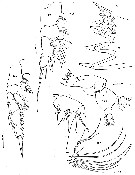 Issued from : C. Séret in Thesis 3ème Cycle, UPMC, Paris 6. [Pl. XXI]. As Euchaeta biloba. Female (from off Kerguelen Is.): 124, right Md; 125, right Md (masticatory edge of gnathobase); 126, right Mxp; 127, P1; 128, P2.
|
 Issued from : C. Razouls in Ann. Inst. océanogr., Paris, 1994, 70 (1). [p.89]. Caractéristiques morphologiques de Paraeuchaeta biloba femelle et mâle adultes. Terminologie et abbréviations: voir à Calanus propinquus. Remarques concernant des formes observées aux Iles Kerguelen (Station Kerfix).
| | | | | Ref. compl.: | | | Sewell, 1948 (p.570); De Decker & Mombeck, 1964 (p.13); Arashkevich, 1978 (p.118, Table: diets); Errhif & al., 1997 (p.422); Ansorge & al., 1999 (p.135, Rem.: p.143); Razouls & al., 2000 (p.343, tab. 3, 5, Appendix); Ward & Shreeve, 2001 (p.50, tab.3,4); Hunt al., 2001 (p.374, tab.1,2); Berasategui & al., 2005 (p.313, fig.2); Auel & Hagen, 2005 (p.1272, Table 2); Park & Ferrari, 2009 (p.143, Table 3, 7: common deep water species, 8, Appendix 1, biogeography); Laakmann & al., 2009 (p.679, fig.2, 4, Table 2); Laakmann & al., 2012 (p.535, Table 1, fig.2, Rem.: molecular Biol.); Ojima & al., 2013 (p.1293, Table 2, 3, abundance); Ward & al., 2014 (p.305, Table 6, abundance in the ''Discovery'' Investigations in the 1930s) | | | | NZ: | 7 | | |
|
Carte de distribution de Paraeuchaeta biloba par zones géographiques
|
| | | | | | | | | | | | 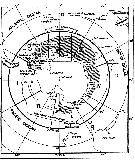 issued from : W. Vervoort in B.A.N.Z. Antarctic Reseach Expedition, Reports - Ser. B, Vol. III, 1957 [Fig.68]. As Euchaeta biloba. issued from : W. Vervoort in B.A.N.Z. Antarctic Reseach Expedition, Reports - Ser. B, Vol. III, 1957 [Fig.68]. As Euchaeta biloba.
Chart showing the geographical distribution (white circle) in the seas surrounding the Antarctic continent.
Nota: In this chart the area frequented by whaling vessels has been hatched. The Antarctic circle (66°.5 S) has been drawn as a broken line. The numbers I to VI refer to the sectors into which the Antarctic seas are divided according to Mackintosh (1942) (after Vervoort, 1951). |
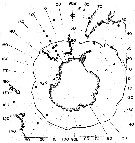 issued from : T. Park in Biology of the Antarctic Seas VII. Antarctic Res. Ser., 1978, 27 (4). [p.220, Fig.76]. issued from : T. Park in Biology of the Antarctic Seas VII. Antarctic Res. Ser., 1978, 27 (4). [p.220, Fig.76].
Occurrence of Euchaeta ( = Paraeuchaeta ) biloba.
Closed circles: stations where the species was found; A.C: Antarctic Convergence. |
 issued from : S. Laakmann, M. Stumpp & H. Auel in Polar Biol., 2009, 32. [p.682, Fig.2]. issued from : S. Laakmann, M. Stumpp & H. Auel in Polar Biol., 2009, 32. [p.682, Fig.2].
Vertical distribution (stages C5 to C6 from Antarctic Polar Front: Atlantic sector).
Error bars encompass the 5th to the 95th percentile. Abundance data are given as mean ± SD.
Nota: This species and P.rasa co-occurred within the same depth range and overlapped in their ranges with P. antarctica. |
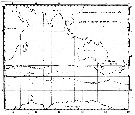 Issued from : C. Séret in Thesis 3ème Cycle, UPMC, Paris 6. 1979, Annexe. [p.35]. Issued from : C. Séret in Thesis 3ème Cycle, UPMC, Paris 6. 1979, Annexe. [p.35].
Geographical occurrences of Euchaeta biloba (= Paraeuchaeta biloba) in the Indian Ocean and Antarctic zone. [after publications from: Brady, 1883, 1918; Thompson, 1900; Wolfenden, 1908, 1911; With , 1915; Rosendorn, 1917; Farran, 1929; Sewell, 1929, 1947; Brady & Gunther, 1935; Steuer, 1929, 1392, 1933; Ommaney, 1936; Vervoort, 1957; Tanaka, 1960; Brodsky, 1964; Seno, 1966; Andrews, 1966; Grice & Hulsemann, 1967; Seno, 1966; Frost & Fleminger, 1968; Voronina, 1970; Zverva, 1972].
C. Séret notes the occurrence at stations 56°S, 70°E; 51°S, 65°E and 46°S, 64°E. |
| | | | Loc: | | | Antarct. (Peninsula, SW & SE Atlant., Indian, Lützow-Holm Bay, SW & SE Pacif.), Magallones region, sub-Antarct. (SW Atlant., off South Georgia, off Prince Edward Is., Indian, Kerguelen Is., Pacif. (SW, SE), SW & W Indian, S Indian (subtropical convergence), off S Tasmania, South Africa (E), Argentina, China Seas (East China Sea), New Zealand (Kaikoura), Chile, Straits of Magellan (Pacific area) | | | | N: | 35 | | | | Lg.: | | | (3) F: 6,4-5,3; M: 5,4-5,1; (20) F: 6,75-5,25; M: 5,66-4,83; (25) F: 6,12; M: 5,09; (35) F: 5,9-5,3; M: 4,9-4,8; (36) F: 5,43-5,64; M: 5; (116) F: 5,37; M: 5,04-4,66; (246) F: 6,24-6,16; {F: 5,25-6,75; M: 4,66-5,66}
The mean female size is 5.822 mm (n = 12; SD = 0.5083), and the mean male size is 5.048 mm (n = 10; SD = 0.2957). The size ratio (male : female) is 0.873 (n = 6; SD = 0.0255) or ± 87 %. | | | | Rem.: | épi-bathypélagique.
Sampling depth (Antarct., sub-Antarct.) : 0-500-1000-4000 m.
D'après Mazza (1966) cette espèce pourrait acquérir un comportement phytophage. Cette hypothèse est basée sur le fait que la plus grande fréquence des mâles apparaît dans l'eau de surface au moment précis où la poussée phytoplanctonique est maximale.
Voir aussi les remarques en anglais | | | Dernière mise à jour : 07/12/2020 | |
|
|
 Toute utilisation de ce site pour une publication sera mentionnée avec la référence suivante : Toute utilisation de ce site pour une publication sera mentionnée avec la référence suivante :
Razouls C., Desreumaux N., Kouwenberg J. et de Bovée F., 2005-2024. - Biodiversité des Copépodes planctoniques marins (morphologie, répartition géographique et données biologiques). Sorbonne Université, CNRS. Disponible sur http://copepodes.obs-banyuls.fr [Accédé le 20 avril 2024] © copyright 2005-2024 Sorbonne Université, CNRS
|
|
 |
 |





























